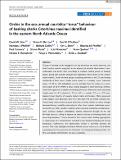| dc.contributor.author | Sims, David W. | |
| dc.contributor.author | Berrow, Simon D. | |
| dc.contributor.author | O'Sullivan, Ken M. | |
| dc.contributor.author | Pfeiffer, Nicholas J. | |
| dc.contributor.author | Collins, Richard | |
| dc.contributor.author | Smith, Kev L. | |
| dc.contributor.author | Pfeiffer, Brianna M. | |
| dc.contributor.author | Connery, Paul | |
| dc.contributor.author | Wasik, Shane | |
| dc.contributor.author | Flounders, Lois | |
| dc.contributor.author | Queiroz, Nuno | |
| dc.contributor.author | Humphries, Nicholas E. | |
| dc.contributor.author | Womersley, Freya C. | |
| dc.contributor.author | Southall, Emily J. | |
| dc.date.accessioned | 2022-09-20T12:13:11Z | |
| dc.date.available | 2022-09-20T12:13:11Z | |
| dc.date.copyright | 2022 | |
| dc.date.issued | 2022-08-05 | |
| dc.identifier.citation | Sims, D. W., Berrow, S. D., O'Sullivan, K. M., Pfeiffer, N. J., Collins, R., Smith, K. L., Pfeiffer, B. M., Connery, P., Wasik, S., Flounders, L., Queiroz, N., Humphries, N. E., Womersley, F. C., & Southall, E. J. (2022). Circles in the sea: annual courtship “torus” behaviour of basking sharks Cetorhinus maximus identified in the eastern North Atlantic Ocean. Journal of Fish Biology,1–22. https://doi.org/10.1111/ jfb.15187. | en_US |
| dc.identifier.uri | http://research.thea.ie/handle/20.500.12065/4049 | |
| dc.description.abstract | Groups of basking sharks engaged in circling behaviour are rarely observed, and their function remains enigmatic in the absence of detailed observations. Here, underwater and aerial video recordings of multiple circling groups of basking sharks during late summer (August and September 2016–2021) in the eastern North Atlantic Ocean showed groups numbering between 6 and 23 non-feeding individuals of both sexes. Sharks swam slowly in a rotating “torus” (diameter range: 17–39 m), with individuals layered vertically from the surface to a maximum depth of 16 m. Within a torus, sharks engaged in close-following, echelon, close-flank approach or parallel-swimming behaviours. Measured shark total body lengths were 5.4–9.5 m (mean LT: 7.3 m ± 0.9 s.d.; median: 7.2 m, n = 27), overlapping known lengths of sexually mature males and females. Males possessed large claspers with abrasions that were also observed on female pectoral fins. Female body colouration was paler than that of males, similar to colour changes observed during courtship and mating in other shark species. Individuals associated with most other members rapidly (within minutes), indicating toroidal behaviours facilitate multiple interactions. Sharks interacted through fin–fin and fin–body contacts, rolling to expose the ventral surfaces to following sharks, and breaching behaviour. Toruses formed in late summer when feeding aggregations in zooplankton-rich thermal fronts switched to non-feeding following and circling behaviours. Collectively, the observations explain a courtship function for toruses. This study highlights northeast Atlantic coastal waters as a critical habitat supporting courtship reproductive behaviour of endangered basking sharks, the first such habitat identified for this species globally. (https://www.youtube.com/watch?v=7i2H1wVOmb4) | en_US |
| dc.format | application/pdf | en_US |
| dc.language.iso | eng | en_US |
| dc.publisher | John Wiley & Sons, Inc. | en_US |
| dc.relation.ispartof | Journal of Fish Biology | en_US |
| dc.rights | Attribution-NonCommercial-ShareAlike 4.0 International | * |
| dc.rights.uri | http://creativecommons.org/licenses/by-nc-sa/4.0/ | * |
| dc.title | Circles in the sea: annual courtship “torus” behaviour of basking sharks Cetorhinus maximus identified in the eastern North Atlantic Ocean | en_US |
| dc.type | info:eu-repo/semantics/article | en_US |
| dc.contributor.affiliation | The Laboratory, Marine Biological Association, Citadel Hill, Plymouth, UK | en_US |
| dc.contributor.affiliation | Ocean and Earth Science, National Oceanography Centre Southampton, University of Southampton, Southampton, UK | en_US |
| dc.contributor.affiliation | Irish Basking Shark Group, Merchants Quay, Kilrush, Ireland | en_US |
| dc.contributor.affiliation | Marine and Freshwater Research Centre, Department of Natural Resources and the Environment, Atlantic Technological University, Galway, Ireland | en_US |
| dc.contributor.affiliation | SeaFever Productions, Woodview Park, Ennistymon, Ireland | en_US |
| dc.contributor.affiliation | MERC Ecological Consultants, Galway, Ireland | en_US |
| dc.contributor.affiliation | Irish Basking Shark Group, Kilkee, Ireland | en_US |
| dc.contributor.affiliation | Basking Shark Scotland, Oban, UK | en_US |
| dc.contributor.affiliation | CIBIO, Centro de Investigação em Biodiversidade e Recursos Genéticos, InBIO Laboratório Associado, Campus de Vairão, Universidade do Porto, Vairão, Portugal | en_US |
| dc.contributor.affiliation | BIOPOLIS Program in Genomics, Biodiversity and Land Planning, Vairão, Portugal | en_US |
| dc.contributor.sponsor | David W. Sims is supported by a Marine Biological Association Senior Research Fellowship. | en_US |
| dc.description.peerreview | yes | en_US |
| dc.identifier.doi | 10.1111/ jfb.15187 | en_US |
| dc.identifier.endpage | 22 | en_US |
| dc.identifier.startpage | 1 | en_US |
| dc.identifier.url | https://onlinelibrary.wiley.com/doi/10.1111/jfb.15187 | en_US |
| dc.identifier.url | https://www.youtube.com/watch?v=7i2H1wVOmb4 | en_US |
| dc.rights.accessrights | info:eu-repo/semantics/openAccess | en_US |
| dc.subject.department | Marine and Freshwater Research Centre | en_US |
| dc.type.version | info:eu-repo/semantics/publishedVersion | en_US |


